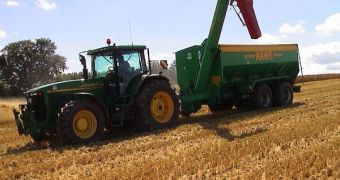Scientists at the National Physical Laboratory (NPL), in Teddington, the UK, have recently announced the creation of a new type of imaging technology, which would allow mechanized and autonomous harvesting equipment to produce the best yield possible from a given stretch of land. The innovation is very important when taking into account the fact that wastage levels and labor shortage, especially in the UK, are reaching alarming levels, and threat food security. Machines equipped with the new system could make that a thing of the past.
According to official statistics, some types of crops and certain areas of the country register annual wastage levels of up to 60 percent, which translates into about 100,000 GBP ($164,000) lost for an average farm every year. In addition to this issue, the farmers that were interviewed in a recent study also said that a significant drop was currently being recorded in the numbers of migrant workers that regularly helped farmers gather their healthy crops at the right time. A lack in workforce means that some crops are harvested before or past their time, reducing their quality, and the owner's chances of selling them well.
“The farming industry does not have access to equipment or the skills required to operate in these parts of the electromagnetic spectrum, few places do. That is why KMS Projects and VHS came to NPL to utilise the world class expertise and equipment that we have on site to try and address this problem. Our aim is to develop a unique new automated harvesting machine that will dramatically improve productivity in the UK and global farming industry and ultimately benefit consumers through cheaper food in the supermarkets,” says NPL project leader, Dr. Richard Dudley.
According to the experts, the four most reliable parts of the electromagnetic spectrum to be used in assessing which crops are ready for harvest and which not are radio frequencies, microwaves, terahertz and the far-infra red. These radiations have the ability to get into the thick leafage surrounding plants and assessing the size of their fruits without endangering the quality of the crops. The system was successfully tested on cauliflowers, which are notoriously hard to look at on account of the vast amount of leaves surrounding them.

 14 DAY TRIAL //
14 DAY TRIAL //